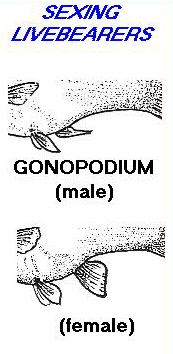




BREEDING
One of the more rewarding aspects of fishkeeping is seeing your fish multiply in numbers.
Most fishkeepers see this as justification in their methods of fishkeeping, although we all know that
many of our fish breed despite of our treatment of them, such is the urge to maintain the species.
METHODS OF
REPRODUCTION: All fish breed from eggs, but it is the
The majority of fish are egg-layers where the fertilised egg develops outside of the fish's body.
The unfertilised eggs are first expelled from the female under stimulus from the attention of the male.
Eggs may be simply released amongst plants or scattered in open water to be fertilised by the free-swimming male;
Several of these methods have evolved to give better protection for the development of the egg and subsequent fry.
Alternatively, with the livebearing fishes, the fertilised eggs remain in the female's body to develop and later emerge as free-swimming fry.
Such are the diverse methods awaiting fishkeepers wanting to breed their fish.
SEXING : The first practical barrier to overcome is sexing the fish and making
It is important to strictly control which fish breeds with which: livebearers are notoriously promiscuous and will interbreed indiscriminately.
Egglaying species need to be observed a bit more carefully.
When in breeding condition, males develop
Download this complete Care Sheet
development of the fertilised eggs that gives
us the diversity in reproduction methods.
they may be deliberately laid on a pre-selected spawning site
or placed in a floating bubblenest;
they can be laid out of water on an overhanging terrestrial plant leaf (or on the tank's cover glass);
they can be buried in the substrate;
they can be incubated in the parent's mouth.
A variation in this method allows females to store sperm from the male so that further batches of young can be produced without any further 'mating' being required.
An even more sophistication allows developing fry to obtain nutrients from the female via a primitive 'placenta'.
sure
you have a male and a female to breed with. Livebearing species are easy to sex: the male has the anal fin transformed into a rodlike structure, the gonopodium, through which he injects sperm into the female. Females have the traditional fan-shaped anal fin.
Livebearing species are easy to sex: the male has the anal fin transformed into a rodlike structure, the gonopodium, through which he injects sperm into the female. Females have the traditional fan-shaped anal fin.
Only put together fish of the same strain unless you really want a thankful of 'mongrels' as a result! Males are generally more colourful and have longer finnage.
Males are generally more colourful and have longer finnage.
Females usually are plumper in the body
(due to the build up of eggs) when viewed
from above.
Egglayers generally breed true without too many surprise packages amongst the offspring. Sexing Goldfish:
Sexing Goldfish:
small white breeding 'tubercles' on the
gill-covers and on the first thick rays of
the pectoral fins (see ringed areas, left).
© FBAS 1998 RCM/RDE Aquarium Management Care Sheet 7 1/2